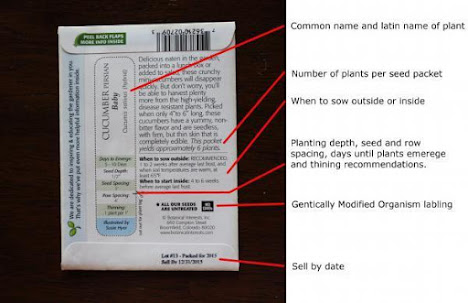by Annette MaCoy, Penn State Extension, Franklin County
SEED CATALOGS are arriving in mailboxes now. Seeds offer an opportunity for gardeners to grow old favorites and try new varieties at a much lower cost than purchased plants. The selection of seeds available from catalogs is extensive; you can find unusual varieties not sold or grown by local nurseries or garden centers. It takes some time and effort to start seeds successfully, but many are very easy for beginning gardeners to grow.
When we order seeds from a catalog, or when we purchase packets of seed in the spring, we are drawn to the colorful flower or vegetable pictured. It is important also to pay attention to the information and instructions provided, which can spell the difference between success and failure.
 |
| Seed Packet Info (Photo:B.WIlliams, NC State) |
Here is some of the information usually included in catalogs and on seed packets:
- Description – includes common and scientific name, plant height at maturity, days to harvest or bloom, growth habit (for instance, vining), life cycle (annual or perennial), and suggested uses for the plant.
- HARDINESS ZONE – for perennials, this designation indicates how well the plant will survive average minimum low winter temperatures. The United States is divided into bands, or zones, with lower numbers indicating colder areas. Franklin County is in Zone 6, so perennials or woody plants that you select should be listed as “hardy to zone 6” or colder.
- Hybrid or Open Pollinated – these terms refer to how these seeds were bred or created. Hybrid seeds, often called F1 hybrids, are the result of a specific cross between two carefully maintained parent plants to create a variety with hybrid characteristics and vigor. Open pollinated plants, on the other hand, are varieties that are pollinated naturally; these are often called “heirloom” or “antique” varieties and exhibit characteristics that are usually stable from year to year. They may be less vigorous or less disease resistant than F1hybrids but have other attributes, such as flavor or fragrance, that make them worth growing.
- Weight - either a weight or number of seeds is noted; this is useful in determining how much seed or how many packets you will need for the area you are planning to plant.
- Date – the year for which the seeds were packaged, e.g., “Packed for 2021” and a sell-by date, as well as the country of origin, are included. It’s important to know this date, because as seeds age, their germination rate declines. If you sow seeds from several years ago, you may get fewer seeds sprouting as their viability decreases.
- Planting Directions – when to plant, planting depth, spacing, light exposure requirements, days to emergence, whether the seeds should be started indoors or can be planted directly outdoors; all this information will help you to grow a successful crop.
Although we often don’t think much about it, a seed is an extraordinary thing. Seeds come in myriad shapes and sizes, and plants have evolved ingenious methods to disperse seed. A seed is basically a container that is generally small, easily stored, and able to withstand conditions that would kill its parent plant. No matter how small the seed, contained within that seed coat is a dormant plant, complete with root, stem, and leaves, most of the time with a food source – either seed leaves or endosperm – to provide nourishment to the embryo seedling. A seed survives cold, drought, heat, sometimes for hundreds of years, just waiting for the right conditions of moisture and light to germinate.
Here are a few interesting facts about seeds:
- Seeds provide more food for human beings than any other plant or animal – think of rice, corn, wheat, barley, oats, peanuts, and nuts. The second largest of all known seeds is the familiar coconut. It can float, sometimes thousands of miles, on the ocean because of its hollow cavity and fibrous coat.
- Some seeds, such as those of orchids and begonias, are as fine as dust. The seed capsule of one orchid flower contained over 3 million seeds.
- Many common weed seeds, such as lambs’ quarters, ragweed, and foxtail, can survive up to 40 years buried in the soil
 |
| Seed Vault Items (Photo Courtesy of Svalbard) |
- The Norwegian government has built a SEED VAULT at Svalbard, 390 feet inside a sandstone mountain on the island of Spitsbergen, to collect and preserve the genetic diversity of over 4.5 million samples of different seeds.
At the end of the season you may want to SAVE SEEDS FROM YOUR GARDEN. Here's some tips from Penn State.
Also remember, when saving seeds, that germination rates will decline over time. You may want to test the viability of any saved, or shared, seeds. Check out TEST YOUR SEEDS FOR VIABILTY on this blog.
* * * * *
Interested in herbs? Looking for a gift?
Perfect for a hostess gift, or birthday or housewarming.
And there is a price reduction as we look forward to spring gardening.
Check out the Herb Sampler on this Blog
SPECIAL Price reduction on this 5 * * * * * book
The Second Edition Herb Sampler (2019) is available through Amazon.
Just click this link to find it.






No comments:
Post a Comment